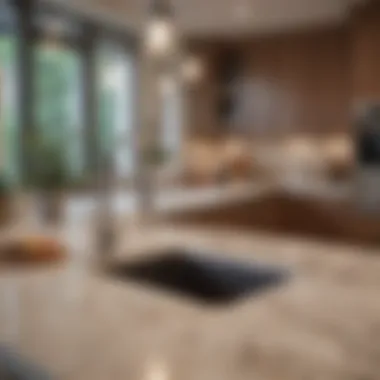Essential Guide to Deep Cleaning Your Home


Intro
Deep cleaning is quite a chore; often many of us only think about it when it becomes unavoidable. Whether it’s prepping for a special occasion or just trying to reclaim your living space from years of neglect, a thorough clean can transform not just the appearance of a home, but also enhance the well-being of its residents. When approaching a full house deep clean, there’s more than just scrubbing floors and wiping counters; it’s about creating a sanctuary—an environment that reflects both your style and the comfort of a livable space.
Full house deep cleaning isn’t just about hygiene; it's about creating a peaceful atmosphere. It can even be a great way to declutter your mind. As you navigate through each room, the satisfaction of seeing a neat and tidy space grows, positively impacting mental clarity. But this kind of cleaning isn’t limited to aesthetics; it holds real importance in maintaining the longevity of your home as well.
In the sections that follow, we’ll explore the ins and outs of deep cleaning your home—from understanding the methods involved to recognizing the psychological effects of a clean environment. We’ll also examine practical tips and strategies that can be implemented, no matter the size or layout of your house. By the end of this guide, you should feel equipped and empowered to tackle the challenges and reap the rewards of a transformative deep-cleaning journey.
Architectural Inspiration
Cleaning effectively involves more than just elbow grease; understanding the space you're working in can greatly impact the results. Different architectural styles, materials, and designs all play a part in how one approaches a deep cleaning task. Consideration of architecture can add a unique layer to your cleaning efforts.
Overview of Design Styles
From minimalist to arts and crafts, every design style brings its own flair and challenges for cleaning. Modern homes, often filled with open spaces and large windows, might require special attention to dusting and window care, as their beauty is in the light that shines through. On the other hand, more classic Victorian homes, with detailed moldings and ornate fixtures, may demand a more delicate approach when it comes to maintenance.
Understanding your home’s layout and architectural details allows you to tailor your cleaning process:
- Minimalist Homes: Focus on reducing clutter before cleaning surfaces.
- Traditional Architecture: Pay close attention to intricate details that require gentle cleaning techniques.
- Open-concept Spaces: Target areas where dirt and dust tend to accumulate, especially corners and hard-to-reach spots.
Adapting your cleaning strategy according to the architectural characteristics can make the task feel less daunting and more strategic.
Innovative Materials and Techniques
The evolution of materials used in home design can also affect cleaning methods. For instance, many new kitchen countertops made from quartz or granite require specific cleaniong agents that won’t damage their surfaces. In contrast, vintage wooden pieces might need more traditional care techniques to retain their charm and function.
When you have a space filled with various materials, consider these useful cleaning practices:
- Use microfiber cloths for effective dusting without leaving residues.
- Apply green cleaning products for a non-toxic approach to sanitation, particularly on porous surfaces.
- Incorporate steaming devices to sanitize without chemicals.
These approaches not only enhance the efficacy of your cleaning endeavors but also align with sustainable practices, promoting a healthier environment.
A deeper understanding of architectural styles and materials can greatly enhance the efficiency of your cleaning efforts, turning a simple task into a mindful practice.
Prolusion to Full House Deep Cleaning
In today's fast-paced world, maintaining a clean home can often take a backseat to our busy lives. However, the idea of a full house deep cleaning transcends mere aesthetics. It serves as a pillar in the quest for a serene living environment. When rooms are not just tidied but thoroughly scrubbed, the impact on both physical and mental well-being is profound.
Why is a comprehensive deep clean so important? It goes beyond sweeping and dusting; it’s about creating a space that promotes health, clarity, and comfort. Understandably, many might view this approach as a daunting task, but breaking it down into manageable steps can transform the cleaning experience into a gratifying journey.
One cannot ignore the tangible benefits that come with deep cleaning. For instance, it can significantly reduce allergens, ensuring you and your family breathe easier. This is particularly crucial for those who suffer from asthma or allergies. Furthermore, a profoundly clean house can enhance feelings of productivity and relaxation—a clean slate offers mental clarity that encourages focus and creativity, whether you're working from home or planning your next adventure.
What to Consider When Deep Cleaning
When setting out on the path of deep cleaning, it’s vital to consider the scale of the task. Is it a seasonal chore or part of a broader home maintenance plan? Assessing the individual needs of each room and tailoring your approach can be the difference between overwhelming chaos and a streamlined process.
Some elements to keep in mind include:
- The Scope: Different rooms have different requirements. A kitchen can be more intensive compared to a bedroom.
- Supplies: Ensuring you have the right cleaning products and tools is fundamental to achieving an effective clean without running into snags midway.
- Time Management: Allocate enough time for the project; rushing can lead to overlooked areas and incomplete tasks.
"A clean home isn’t just a luxury; it’s a necessity that contributes to your overall well-being."
All things said, embarking on a full house deep cleaning journey not only revitalizes your living space but also provides an opportunity for personal reflection—making it a worthwhile endeavor no matter how you slice it. As we move forward, the forthcoming sections will unravel the specifics of defining deep cleaning, its benefits, and how to prepare efficiently for the task ahead.
Defining Deep Cleaning
Deep cleaning goes beyond the standard tidying up that many people might do on a weekly basis. It's the meticulous, no-stone-unturned kind of cleaning that involves every nook and cranny of your house. The concept of deep cleaning might sound simple, but it encompasses a great deal of importance, especially for folks who get a kick out of elevating their home's ambiance and hygiene.
The essence of deep cleaning is not just about making surfaces shine; it's about thoroughly combating dirt, buildup, and allergens that accumulate over time. In rooms such as kitchens, where grease and food particles linger, or bathrooms, where moisture can breed mold and mildew, deep cleaning is vital. It is the process of stripping away these threats, contributing to a healthier living space.
Key Elements of Deep Cleaning
Deep cleaning involves several specific elements:
- Thoroughness: Every surface receives attention, from high ceilings to floorboards. Light fixtures are dusted, and shelves are organized. There’s a meticulousness that regular cleaning often overlooks.
- Cleaning Agents: The use of dedicated, often stronger cleaning agents designed to tackle stubborn stains and buildup sets deep cleaning apart from regular cleaning. While household cleaners might suffice for daily spills, a deep clean might call for something like bleach for bathroom tiles or a powerful degreaser in the kitchen.
- Time Investment: Unlike routine cleaning that may be completed in an hour, deep cleaning requires more time and effort, often taking several hours, depending on the size of the home and the extent of dirtiness.
Benefits of Deep Cleaning
As we discuss the importance of defining deep cleaning, consider the myriad benefits that a full house deep clean can offer:
- Healthier Environment: By removing allergens like dust mites and mold, deep cleaning enhances the air quality and overall hygiene of the home.
- Prolonged Lifespan of Items: Regularly deep cleaning carpets, upholstery, and other surfaces can lead to a longer life for these items, saving homeowners money in the long run.
- Psychological Clarity: A clean home is often synonymous with a clear mind. The act of deep cleaning often leads to decreased stress and anxiety levels, creating a more inviting atmosphere.
Considerations for Deep Cleaning
It's also essential to bear in mind a few considerations:
- Assessing the Need: Some homes may require deep cleaning more often than others. For instance, homes with pets might need to tackle fur and dander more frequently.
- The Right Frequency: Depending on lifestyle, certain areas might need a deeper clean once a month or quarterly, while others may require it once or twice a year.
Deep cleaning is not just an aesthetic upgrade; it’s a comprehensive approach to maintaining a healthy living environment. By defining deep cleaning and understanding its nuances, readers become better equipped to embrace this detailed, yet necessary, aspect of home maintenance.
"A clean home is a sign of a wasted life." - Unknown
This adage might hold some humor but speaks to the fact that deep cleaning should be an intentional act, not merely an obligation.
Benefits of Full House Deep Cleaning
Deep cleaning a home is not just about making it look good. It encompasses a range of benefits that touch upon both psychological and health aspects. By dedicating time to deep cleaning, homeowners can experience immediate rewards in their daily lives, leading to a more productive and enjoyable living environment.
Psychological Benefits


Reduced Stress Levels
Reducing stress is one of the core advantages of committing to full house deep cleaning. When living spaces are cluttered or dirty, it can lead to feelings of chaos and disorganization. For many, a clean home brings a sense of control and calmness. It’s like taking a breath of fresh air after diving into a pile of responsibilities. The serene backdrop of a spotless environment can truly be a balm for the weary mind. As soon as you see your spaces rejuvenated, the weight on your shoulders begins to dissipate, allowing thoughts to flow more freely.
Increased Productivity
A direct correlation exists between a tidy environment and heightened productivity. When the home is well-organized, it takes less time to locate items and less mental energy to navigate the space. The absence of distractions helps in maintaining focus. For instance, have you ever noticed how hard it is to concentrate on work when faced with looming dust bunnies or scattered papers? Getting rid of that visual noise can pave the way for new ideas and efficient execution of daily tasks. People often find that after a thorough deep clean, they tackle their to-do lists with renewed vigor.
Enhanced Mood
A deep clean positively impacts one’s mood significantly. Studies have indicated that a clean living environment can trigger the release of dopamine—a neurotransmitter associated with pleasure and satisfaction. The act of cleaning itself can be a therapeutic exercise, resonating in a way that aligns with one's personal well-being. You step back and admire the fruits of your labor, and it sparks joy. This uplifted mood can further encourage day-to-day activities, leading to a cycle of happiness and accomplishment.
Health Implications
Allergen Reduction
Cleaning effectively helps minimize allergens that accumulate in a home over time. Dust mites, pet dander, and mold are common contributors to allergies, and tackling these during deep cleaning can lead to long-term relief for sensitive individuals. With a keen eye for cleaning under sofas, behind appliances, and in seldom-used corners, homeowners can ensure a decreased allergen load. The key characteristic of allergen reduction is its direct impact on one’s well-being, making it essential for families with health concerns.
Preventing Pests
A clean home is less inviting to pests. Regular deep cleaning clears away food residues, crumbs, and clutter that attract unwanted guests like ants or roaches. By maintaining a clean space, one can significantly reduce the chances of a pest infestation. The unique feature of pest prevention through cleaning lies in the proactive versus reactive approach. It’s more effective to regularly deep clean, rather than waiting for a problem to arise.
Improved Indoor Air Quality
Lastly, one of the less obvious yet critical benefits of full house deep cleaning is improved indoor air quality. When a home is dusted, vacuumed, and washed, it becomes a breath of fresh air—literally. Filtration systems in your home air can only do so much if they are continuously cycling dust and indoor pollutants back into the environment. Deep cleaning means those particles are removed, leading to a healthier space to breathe. Indoor air quality is often an afterthought, but it can dramatically influence overall health in the long run.
"A clean home is a happy home, which resonates in its atmosphere, inviting peace to dwell within."
In summary, embracing full house deep cleaning leads to a mosaic of benefits that extend from mental clarity to actual health enhancements. With a clearer mind and a healthier body, homeowners are likely to enjoy their spaces even more.
Preparing for an Effective Deep Clean
When it comes to deep cleaning your home, the preparation phase can’t be skipped. It’s the backbone of a successful endeavor. Think of it as laying the groundwork before building a house; if the foundation isn’t solid, you can’t expect the rest to stand tall. Preparing for an effective deep clean ensures that you not only tackle every nook and cranny but also do so in an organized way that prevents unnecessary stress.
Creating a Cleaning Schedule
A clear cleaning schedule is your best friend when diving into a full house deep clean. It serves as a roadmap, helping you avoid detours that could lead to frustration. Start by breaking down your spaces; treat the living room, kitchen, bathrooms, and bedrooms as individual projects.
Here’s how to go about it:
- Assess your time: Figure out how much time you can realistically dedicate each day to cleaning. Be honest with yourself to avoid getting in over your head.
- Prioritize tasks: Use your schedule to highlight what needs attention first. Heavily used spaces, especially kitchens and bathrooms, should usually take precedence.
- Stick to a routine: Once you've established a cleaning frequency—whether it’s weekly or monthly—commit to it.
A well-planned schedule not only boosts your productivity but also injects a sense of accomplishment when you check off items as complete.
Gathering Necessary Supplies
A well-equipped cleaning arsenal can make a world of difference. Let's unpack what you need:
Cleaning Agents
Choosing the right cleaning agents is crucial in your deep cleaning strategy. These are your heavy hitters, designed to tackle stains, bacteria, and dirt. One key characteristic is their efficacy; whether it's an all-purpose cleaner or a specialized tile solution, effective cleaning agents drastically reduce the time needed for scrubbing and give you better results.
- Why they matter: Strong cleaning solutions ensure that surfaces are not just clean, but sanitized, which is especially important in areas prone to germs.
- Considerations: Some cleaning agents might contain harsh chemicals, so take note of allergies or sensitivities in your household. Opting for eco-friendly options is becoming increasingly popular not just for health benefits but also for minimizing environmental impact.
Tools and Equipment
The right tools can elevate your cleaning game. Think of brushes, mops, vacuum cleaners, and microfiber cloths. A key feature of these tools is versatility. For instance, a vacuum cleaner with various attachments can be utilized for different surfaces, from carpets to upholstery.
- Benefits: Using the right tools facilitates quicker cleaning and often yields better results. You avoid damaging surfaces while ensuring thoroughness.
- Drawbacks: Some equipment may have a higher upfront cost. However, investing in quality tools that last can save money over time and improve efficiency.
Protective Gear
Last but not least, don’t forget to outfit yourself with proper protective gear. Gloves, masks, and maybe even goggles should make an appearance in your cleaning toolkit. One of the key aspects is safety. Protecting your skin and respiratory system from harsh chemicals is vital.
- Why it matters: Safety shouldn’t be compromised when cleaning, especially when using potent agents that can irritate or cause allergic reactions.
- Unique features: Many protective gear options are designed for comfort and ease of use, allowing for more extended cleaning sessions without discomfort.
Each part of preparing for your deep clean contributes to a smoother process. It sets the tone for whatever comes next, framing your efforts in a way that promotes success and satisfaction. Get these elements right, and you're well on your way to a home that sparkles and shines.
Room-by-Room Cleaning Approach
Cleaning your home is no small task, but taking a room-by-room approach not only organizes the process but also minimizes overwhelm. This method ensures thoroughness and allows for focused attention on specific areas, making it easier to see progress and maintain motivation. Deep cleaning a whole house can feel like a mountain to climb, but breaking it down into smaller tasks turns the job into a series of manageable hills.
Living Room and Common Areas
Surface Dusting Techniques
When it comes to the living room, surface dusting is where the process starts. This technique involves using a microfiber cloth or a duster to gather dust from all surfaces, including shelves, mantles, and electronics. The key characteristic of surface dusting is its simplicity; it effectively removes allergens and dirt that accumulate over time. This approach is not only a beneficial choice for maintaining air quality but also enhances the overall aesthetic of the space by revealing the true colors of furniture and decor.
A unique aspect of proper dusting is how it prevents particles from settling into upholstery and carpets, thus extending their lifespan. However, one must be careful with delicate items, as using the wrong technique could lead to breakage.
Floor Cleaning Strategies
Next, let's step down to the floors. Each type of floor, whether tile, wood, or carpet, has its own cleaning strategies. The heart of an effective floor cleaning strategy is using the right tools. For hardwood floors, a damp mop can work wonders, while tile floors may require a good scrubbing brush to tackle grout lines. This targeted method is essential for removing hard-set stains and giving the flooring a fresh look.
What makes floor cleaning particularly advantageous is its immediate visual impact—once done, the difference is often striking. However, keep in mind that the wrong cleaning solution can damage certain floor types, so awareness is key.
Upholstery Care
Taking care of upholstery involves another layer of deep cleaning. Regular vacuuming, coupled with occasional steam cleaning or spot treatments, helps to maintain the integrity of sofas and chairs. Upholstery care is fundamental because fabrics can trap allergens and odors, turning your beloved couch into a health risk.


One of the standout features of proper upholstery care is its role in prolonging the life of your furnishings. While professional steam cleaning can be a bit costly, DIY methods using vinegar and baking soda can be effective and budget-friendly. Just be cautious as some fabrics may react poorly to these substances.
Kitchen Essentials
Appliance Deep Clean
The kitchen is the hub of home life, which makes appliance deep cleaning crucial. This involves disassembling major appliances such as the oven, refrigerator, and dishwasher to clean every nook and cranny properly. While it may seem tedious, this practice ensures that appliances operate efficiently.
The beauty of appliance deep cleaning is in the health benefits gained from a sanitized cooking space. Although it takes effort, the pay-off in terms of functionality and hygiene is significant.
Surface Sanitization
Surface sanitization goes hand-in-hand with appliance cleaning. This task focuses on countertops, tables, and chairs—all areas where food is prepared and consumed. With suitable cleaners, conscientious wiping down of surfaces drastically reduces the risk of foodborne illnesses.
A key characteristic of this strategy lies in using non-toxic cleaning agents, emphasizing safety for your family. It's worth noting that while surface sanitization is essential, it should not replace regular deep cleans.
Organizing Cabinets
Next up is one of the most overlooked tasks: organizing cabinets. Taking the time to sort through your kitchen items can result in immense gains in both time and space. Categorizing things like pots, pans, and dry goods not only saves time while cooking but enhances aesthetics as well.
The unique feature of a well-organized cabinet system is easy accessibility. On the flip side, if you're not consistently maintaining this organization, things can quickly return to chaos, which makes upkeep a consideration.
Bathroom Focus Areas
Tile and Grout Treatment
Bathroom cleanliness requires special attention to tile and grout. Their porous nature allows grime and mildew to take hold, making thorough cleaning essential. Having a steady routine for cleaning tiles and grouts prevents long-term damage and keeps surfaces looking pristine.
The highlight here is the effectiveness of specialized cleaning agents designed for such surfaces. While these products can sometimes be harsh, they're incredibly effective in eliminating stains that regular cleaning might miss.
Fixture Maintenance
Also critical is fixture maintenance. Regularly cleaning faucets and showerheads prevents mineral build-up, ensuring water flow remains optimal. This proactive measure not only reduces the need for future repairs but also enhances the appearance of your fixtures.
Its primary advantage is how it streamlines everyday tasks. However, be wary of using abrasive cleaners on delicate finishes, which could lead to quick degradation.
Ventilation Importance
Lastly, understanding ventilation's role in bathroom maintenance is key. Proper airflow reduces humidity, deterring mold and mildew growth, both detrimental to a clean bathroom. Installing exhaust fans or opening windows regularly can enhance circulation.
The unique aspect of focusing on ventilation is the long-term protection it offers to your home. However, neglecting this can lead to major cleaning hassles down the line.
Bedrooms and Personal Spaces
Bedding Care and Maintenance
In bedrooms, bedding care is a cornerstone of cleanliness. Regular laundering of sheets, pillowcases, and duvet covers not only fosters a hygienic sleeping environment but also promotes better sleep quality.
The essence of bedding care lies in its simplicity; frequent washing prevents dust mites and allergens from taking residence in your fabric. Skipping this essential step can result in unpleasant odors and compromised comfort.
Closet Organization
Closet organization can feel like a daunting task, but once tackled, it pays dividends. Sort clothing by type and season, and consider donating items that are no longer used. This not only clears out space but also makes getting dressed easier.
A key characteristic is the psychological benefit of seeing a neat, organized closet every day; it starts your day off on the right foot. However, allowing the closet to get cluttered again can be frustrating, leading to a cyclical battle.
Decluttering Strategies
Finally, let’s discuss decluttering strategies. Regularly assessing what you own and discarding items that no longer serve a purpose can lighten both a room and your mind. This mental and physical decluttering can lead to increased productivity and reduced stress.
The unique benefit of adopting a decluttering mindset is its ability to transform your living space, making it more inviting and serene. Still, remember that it can be an emotional process, as attachment to items can complicate decisions.
Maintaining a clean environment requires a systematic approach, leading to heightened satisfaction and health benefits. Balancing cleanliness and comfort can be achieved through well-defined cleaning routines following a methodical process–one room at a time.
Professional vs. DIY Deep Cleaning
When it comes to deep cleaning your home, deciding between hiring a professional service or rolling up your sleeves and tackling the job yourself is no small issue. There’s a lot to ponder over, and each choice comes with its own set of pros and cons that can impact not just the cleanliness of your home, but also your time, budget, and peace of mind.
When to Hire Professionals
There are moments when calling in the pros is just plain wiser. If your cleaning list reads like a novel — think heavy-duty tasks like carpet shampooing, washing windows high above ground, or removing stubborn mold — then hiring a professional might save you a world of hassle. You also may be dealing with specific issues, such as hoarding situations or specialized cleaning needs, where expert assistance would be beneficial.
"Sometimes, it’s about knowing when to let someone else handle what feels overwhelming."
Moreover, if you’re short on time, professionals can efficiently work through your home without the stress of managing multiple tasks, leaving you free to carry on with your regular life. It’s also worth mentioning that many professional services come equipped with advanced tools and eco-friendly products that can offer a deeper clean than most households can achieve with their standard supplies.
Cost Analysis of Professional Services
Let's talk numbers. Typically, the cost of professional deep cleaning can vary depending on the size of your space, the services you require, and geographical location. You might be looking at anywhere from a few hundred dollars to upwards of a thousand for larger homes with intensive cleaning needs. However, understand that opting for professional services can sometimes be more cost-effective in the end.
You'll want to consider the value of your time. How much would you pay for a few hours of your life back if cleaning isn't your cup of tea? Additionally, think about potential costs from damage if a cleaning mishap happens during a DIY attempt — for instance, using the wrong cleaner on delicate surfaces.
DIY Cleaning Techniques
Opting for a do-it-yourself approach has its merits. First off, it’s surely lighter on the wallet. Anyone can implement DIY techniques that utilize common household items. Read on for some specialized strategies to tackle deep cleaning effectively.
Budget-friendly Solutions
DIY cleaning solutions can be incredibly economical. Vinegar, baking soda, and dish soap can become your best buddies, serving a multitude of cleaning needs without breaking the bank. For example, a simple mix of baking soda and vinegar can work wonders on clogged drains or tough stains. This is a beneficial choice for those looking to save cash while achieving a clean home.


Not only is it cost-effective, but utilizing these materials presents its unique advantages like:
- Lesser exposure to harsh chemicals
- Environmentally friendly
- Easier to store unused supplies
However, keep in mind that not every issue can be solved with DIY methods alone. Stubborn stains or complex areas may still require professional touch at some point.
Time Management Tips
Time — it’s a precious commodity. When cleaning your home, effective time management can drastically influence how troublesome the task becomes. A key approach here is making a definite cleaning schedule, breaking down tasks into manageable chunks. For instance, designate one day to focus solely on the kitchen and another on the bathrooms. This not only keeps you organized but also prevents burnout.
Many find that tackling smaller sections of the home is less daunting than a full-on blitz.
Remember, keeping a list provides a clear roadmap that can keep you focused and on track throughout your cleaning ventures.
Personalized Approaches
There's no one-size-fits-all when it comes to cleaning. Everyone’s home has unique needs and personal preferences. By customizing your approach, you can address specific areas that require attention most.
Personalized cleaning strategies might include focusing more on high-traffic areas or using particular products that align with your family's sensitivities. Customize your techniques to suit the spaces you inhabit. This is a valuable choice in achieving a truly thorough clean that best meets your requirements.
On the downside, a personalized approach can sometimes lead to overthinking or procrastination, especially if you feel the need to perfect every detail. Finding a balance is key.
Ultimately, whether you choose to hire professional help or embrace the DIY spirit depends on your circumstances. The goal is to foster a fresh and inviting living environment that enhances your well-being and reflects your efforts.
Sustainable Cleaning Practices
In today's fast-paced world, the significance of sustainable cleaning practices has become more apparent than ever. These go beyond simply ensuring your home is clean; they reflect a commitment to protecting our environment while maintaining a healthy living space. By adopting eco-friendly cleaning methods, not only do you contribute to lowering your carbon footprint, but you also create a safer atmosphere for yourself and your family. The benefits of sustainable cleaning practices reach far and wide, influencing everything from personal well-being to the health of our planet.
Eco-friendly Cleaning Agents
Choosing eco-friendly cleaning agents is a crucial step in sustainable cleaning. Traditional cleaning products often contain harsh chemicals that can be harmful not only to your health but also to the environment. In contrast, eco-friendly alternatives are usually derived from natural ingredients that are biodegradable and less toxic. This makes them safer for both users and the planet.
Some popular eco-friendly cleaning agents include:
- Baking Soda: An excellent abrasive cleaner that can tackle grime on various surfaces.
- Vinegar: Effective for cutting through grease and also serves as a natural disinfectant. Its acidity can dissolve mineral deposits, making it perfect for bathroom fixtures.
- Castile Soap: A versatile product made of vegetable oils, which can clean everything from floors to dishes without the harshness of synthetic detergents.
- Essential Oils: Not just for aroma, they often have antibacterial properties. Adding a few drops of tea tree or lavender oil can enhance your cleaning solution.
By opting for these natural substances, you're doing your bit not just for your home but for the greater good.
Reducing Waste during Cleaning
Waste reduction during cleaning is another key aspect of sustainable practices. It’s all about being mindful of what you throw away and seeking ways to minimize unnecessary waste.
Here are a few strategies to consider:
- Use Reusable Cleaning Supplies: Instead of disposable wipes, opt for washable microfiber cloths that can be laundered repeatedly. This cuts down on landfill waste.
- Bulk Purchase: Buying cleaning supplies in bulk reduces packaging waste. Look for refill stations where possible.
- Repurpose Items: Before tossing away, think of other uses for items like old t-shirts or towels. They can be great dusters or rags.
- Avoid Single-use Plastics: Whenever possible, select products without plastic packaging. Many brands now offer eco-friendly packaging options.
Every small change adds up. By reducing waste in your cleaning routines, you contribute to a larger movement towards sustainability, creating a ripple effect that leads to more significant environmental impact.
Incorporating these sustainable cleaning practices into your home not only enhances cleanliness but also instills a sense of responsibility towards the environment. As a real estate enthusiast, travel lover, or an interior design aficionado, embracing sustainability in your cleaning routine positions you as a forward-thinking individual who values not just aesthetics but also ethical living.
Maintaining Cleanliness Post Deep Clean
Keeping a home clean after a substantial deep-clean session is in many ways as significant as the deep clean itself. Once that fresh scent fills the air and surfaces gleam, it’s essential to adopt practices that maintain this spotless environment. Beyond a superficial result, regular upkeep supports overall well-being and fosters a welcoming atmosphere, making it easier to enjoy your living space.
Benefits of Maintaining Cleanliness
- Extended Cleanliness: Regular maintenance can keep dirt, dust, and grime from accumulating. This keeps your home looking great long after a deep clean.
- Health Benefits: A clean home reduces allergens and bacteria, which can lead to a healthier living space.
- Efficiency: By maintaining cleanliness, tasks become more manageable. An ounce of prevention is worth a pound of cure, as the saying goes.
Considerations for Post-Clean Maintenance
- Regular schedules are key.
- Make cleaning a habit rather than a chore.
- Utilize simple tools and checklists to stay organized.
Regular Cleaning Routines
Establishing regular cleaning routines helps sustain the freshness achieved in a thorough deep clean. A systematic approach ensure tasks don’t become overwhelming.
Setting Up a Routine
- Daily Tasks: Wipe down kitchen surfaces, organize clutter, and take out the trash. These little tasks can take mere minutes but have a profound effect.
- Weekly Tasks: Vacuuming, mopping floors, and cleaning mirrors. Dedicating one day a week, say Saturday, can be beneficial for tackling these chores.
- Monthly Tasks: Dusting blinds, cleaning ceiling fans, and organizing closets. Devote time each month to target specific areas that may need a little extra attention.
"A consistent cleaning schedule, no matter how simple, can turn a chaotic space into a sanctuary."
By creating a visible plan or using physical reminders like calendars or smartphone alerts, you can keep yourself accountable.
Decluttering Habits
Declutter habits are just as crucial for maintaining post-deep clean cleanliness. The idea is straightforward: if items don’t spark joy (yes, it’s catchy, thanks to the popular tidying up movement), then consider letting go.
Developing Healthy Decluttering Habits
- Regular Intervals: Set aside a specific time weekly to go through items. Whether it’s just 15 minutes on Thursday evenings, this habit can gradually minimize clutter.
- Items in, items out: For every new item you consider bringing home, think about whether you can remove something else. This principle can help in keeping clutter at bay.
- Storage Solutions: Invest in storage bins, baskets, and organizers that make it easier to store items neatly out of sight.
Maintaining cleanliness post deep clean should not feel like drudgery. Instead, it can become a pleasant routine that transforms your space into a true sanctuary.
Finale
In the hustle and bustle of everyday life, the act of deep cleaning one’s home may easily slip down the priority list. However, this article highlights just how critical it is to prioritize a comprehensive deep cleaning regimen. Each room of your house holds not only dust and dirt but also the potential for a healthier living environment and a better quality of life. The psychological and physical advantages are profound; one cannot underestimate the effect a clean environment has on mood and productivity.
A clean home can be a sanctuary. It’s a place where you can unwind after a long day and feel at ease. Engaging in deep cleaning isn’t merely about scrubbing and disinfecting; it’s about creating a space where every corner exudes peace and comfort. Just think on it: when your surroundings are deeply cleaned, you may notice your stress levels decreasing and an increased ability to focus on tasks at hand. The benefits are endless.
Furthermore, understanding when to tackle chores on your own versus when to hire professionals is an essential takeaway from this guide. The cost factors should be balanced against personal time availability and the specific needs of your home. Sometimes, a little professional help can save a lot of headaches and yield better results.
Tip: Consider making deep cleaning part of an annual ritual. When it becomes a tradition, it may just transform the way your home feels year-round.
As we explored sustainable practices throughout this narrative, it's important to adopt eco-friendly methods that not only clean your home but also respect the Earth. Choosing biodegradable products or reducing plastic waste while cleaning can have a positive impact.
In summary, the importance of a thorough deep cleaning cannot be overstated. The process lays the groundwork for both a clean aesthetic and a healthy atmosphere. Making this a regular habit can pave the way for long-term advantages, and ultimately, turning a house into a true home. Remember, a well-kept space is not just visually appealing, it’s an investment in your wellbeing.







